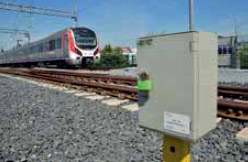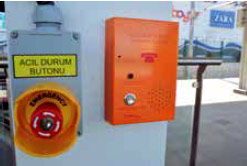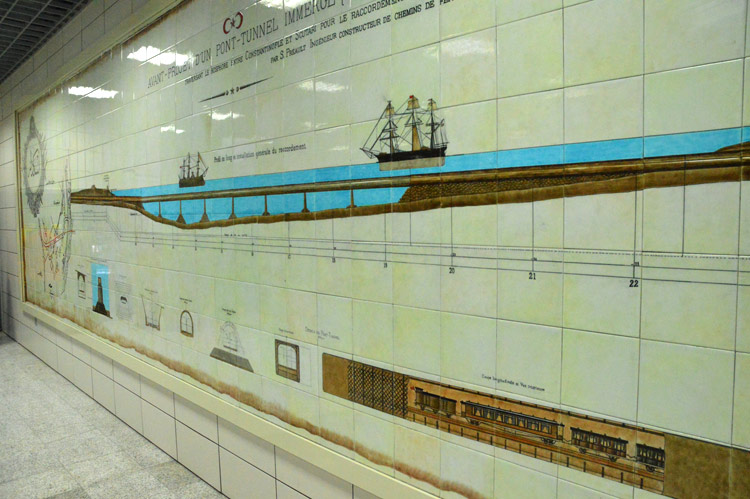|
(14/07/2014)
Revenga contracts in Turkey range from providing protection systems for the now mythical railway tunnel under the Bosporus; also including critical equipment in line safety on the Ankara-Istanbul and Ankara-Konya high-speed train lines; station communications for commuter rail in Istanbul and, finally, maintenance of integrity in the freight infrastructure that will connect the European and Asian networks.
With proprietary technology, the Spanish group has become a small but essential part of Marmaray, the most ambitious railway infrastructure project in recent decades. As important as the construction of the tunnel under the English Channel was in its day.
The Road to Istanbul
But how did Revenga reach this epicentre called Istanbul? There is a recognized human complex that incites us to place ourselves and believe we are at the centre of the world. There are nations and places that believe they are at centre of the world. And some perhaps were at certain points in history. You only need to glance at the map to understand how certain areas are not ordinary places. Their locations meant they were destined to play a special role. And some of them really have played special roles.
A city, an area on the edge of almost everything, the gateway and border with the key to various worlds, which has also been identified with Byzantium throughout history and has received the names of Constantinople and Istanbul, it is certainly no ordinary place.
In the 1980s, crossing over into Asia was a great feat, although the brief trip of just twenty minutes in a 'freshwater boat' between Eminönü in the European heart of the ancient city and Üsküdar, on the other Asian side of the Bosphorus, was no more disturbing than a boat ride in a pond.
But the Marmaray project reveals the enormous power as a wall and, at the same time, as a passage that the narrow strait of the Bosporus has always exercised in the world and, consequently, the global connectivity value possessed by this small, but great tunnel built under its waters in the last decade. 
Europe-Asia
A trip to any part of Central Asia, starting from the south of Europe, which for millennia was the centre of the world, had no other logical option but to pass through a narrow funnel leading to Istanbul.
And there in old Constantinople, there is no other choice but to embark on that domestic, but unavoidable journey between the European and Asian coasts of the 'very narrow' Bosporus strait in order to continue on the long trip.
The alternatives to this natural route are unviable. The passage over the Black Sea makes it necessary to cross ten countries and their borders in a marathon of over 8,000 kilometres. To the south there is only the sea option, through the Mediterranean.
Constantinople, Byzantium, Istanbul is synonymous with a forced transit point between Europe and Asia. This is how the promoters of the Marmaray railway project must have understood it, once again, overwhelmed on the one hand by the ineffectiveness of the ancient solution in old ships and, on the other hand, devastated by the continuous traffic jam represented by the ' modern solution 'of two bridges for automobiles.
SME with ambitions
Founded 42 years ago, Revenga is what might be described as "a signature engineering company". With a staff of 180 workers, it has a team of twenty people dedicated to R&D, and with real talent for innovation. From revenue of around forty million euros a year, it spends up to 3% of its turnover on the development of its own technologies, and with absolute conviction. "Despite our medium size, this is one of the hallmarks of the company we did not want to lose, even in times of crisis," says its CEO Arturo Revenga.
Based on research, Revenga has converted its portfolio of advanced products into the key to diversified survival during four decades in the domestic market and in its business card to the most recent international growth. Its activity includes half a dozen seemingly distant fields in which it has managed to find the common technological link.
In the world of thermal imaging, it provides a solution to fire detection and emergency personnel guidance in tunnels. In the world of telecommunications it offers a solution in passive fibre-optic connections to homes and businesses. In the fantasy world of unmanned aircraft, it has designed a UAV for defence and security applications. It has crossed prison gates through an electronic security pass.
And, finally, the list of specific products created for the world of rail by the R&D department that Revenga has in the Madrid locality of Tres Cantos (point heaters, level crossings, public address and intercom systems and detection and monitoring systems for conditions on travelling trains) has not only allowed the company to enter Turkey, but it has ensured it a comfortable place to establish itself and prosper.
"Technology Partner"
Revenga arrived in Turkey with the appropriate technology but also because, before then, larger Spanish and multinational companies had achieved significant contracts in the different phases of the Marmaray project award and needed efficient partners to give their offers levels of detail they alone could not achieve.
This strategy of alliance and support with the biggest players is embodied in the slogan "Revenga Group, your technology partner". Thus, the OHL construction company and Siemens Rail Automotion have acted as their main protectors and allies in the Turkish adventure.
"Our developments and solutions are a combination of our own ideas and technologies that we are able to interweave very well with other developments of our larger partners", says Arturo Revenga. “In large international contracts our participation involves being part of a consortium where we provide value in what we can do well. In many other cases, the weight of our contribution suggests that we should be behind the construction companies, railway signalling firms or large infrastructure groups". Telefónica, ADIF, Indra, Metro de Madrid, Aena, Repsol, Huawei and the above-mentioned Siemens Rail Automotion or OHL are common companions". We're comfortable besides them and they also look to us because they know we are solvent and competitive in our technological speciality", says Arturo Revenga.
The Marmaray dimension
The infrastructure that allows two-way rail traffic between Europe and Asia through Istanbul and that is known worldwide as Marmaray is a submerged tunnel.
The great work being undertaken since the late twentieth century and which had its first practical result with the opening to commuter rail traffic on 29 October 2013, was not conceived yesterday. The year was 1860 and the Sultan Abdulmecid issued the first underwater connection project, strikingly similar to the infrastructure that 150 years later has become a reality.
The 1,387 metres between the old European part of Istanbul and the Asian locality of Üsküdar have been negotiated by laying two hundred meter long welded cylinders up to 74 metres under the sea. Underground accesses to the surface on both continents, drilled with the TBM, form a 9.4 kilometres tunnel.
But it is in reality much more than a great submerged tube. Marmaray, in its literal translation from Turkish, means "the Marmara rail", explains the Revenga technical manager, Miguel Ángel Adeva. The overall project is divided into five operations to establish a modern and efficient rail connectivity in three concentric circles that have their epicentre in the underground tunnel under the Bosporus.
The first and smallest of these circles is the Istanbul commuter rail network. The second links high speed passenger services between the European and Asian parts of Turkey, and the third opens up the possibility of making east-west rail freight traffic between Asia and Europe a reality.
The control point
Cevgiz Nama, manager of the Turkish railway company TCDD and responsible for traffic control in the tunnel under the Bosporus, emphasises from the provisional control point situated in the Üsküdar underground station, and which will soon be moved, that TCDD has taken great care to use expensive infrastructure with the combination of ERTMS and CBTC systems.
"Not all trains requesting it will receive traffic authorisation", says Nama, taking for granted that, perhaps later rather than sooner, there will be fast passenger and, also, freight traffic through the Marmaray tunnel. 
For now, the network under his surveillance only supports the commuter rail traffic that commenced on 29 October with a route between five stations; two on the Asian side of Istanbul and three on the European side. The result: 140,000 passengers a day.
In short, 35 new stations will enter service, starting at the European terminal of Halkali and ending (or vice versa) at the Asian terminal of Gebze. A network of 80 kilometres that will move 1.2 million passengers each day.
Railway essences
Within a one kilometre radius of the newly opened Sikeci station, one of the first five in the Marmaray service, is the Hagia Sophia, the Blue Mosque, Topkapi Palace, the Galata Tower or the Grand Bazaar. Universal symbols with two thousand years of history on the frontier between two worlds.
Barely three hundred metres from this underground terminal excavated under Istanbul Central Station there is also the Spice Bazaar. It is the oldest trace in the city of the ability of the Turks to convert every corner into a business and any product into a marketable one, and where the ancient artisan essence industry survives.
If essence is, in addition to perfume, also "the purest, finest and most outstanding part of something", Revenga’s participation marks the 'essence' of Marmaray.
No train may travel on the new Eurasian infrastructure without the TCDD railway operator certifying first that its passage will not damage the delicate heart of Marmaray, warns Cevgiz Nama.
In the future, freight trains from the two continents that join up at Istanbul will ask to pass through the underwater tunnel. The task of detecting and monitoring appropriate traffic conditions to give the all clear to each train that arrives at the gates of Marmaray is the delicate task entrusted to the Revenga Group by the operator TCDD. "Something very specific, but essential", says Miguel Ángel Adeva.
To do this, the Spanish company, on the European side, will install a gantry for control and detection of anomalies 40 kilometres from the tunnel, in the town of Halkali. On the Asian side of the project there are another two arches located in the town of Gebze, another 40 kilometres from the submerged Marmaray section.
Adeva outlines that the operation of the abnormality detection arches does not require the inspected train to stop. The six technology control tests implemented by Revenga work on running trains and automatically. "The system is only prepared to stop trains that do not meet the minimum requirements set by TCDD", indicates Adeva.
The train passes under the arch and in the event of any anomaly the system triggers a danger or critical alarm. The alert travels to the control point via the telecommunications network and there the appropriate measures are taken. In situations of serious risk, and even before a decision can be taken by the traffic department, the use of the signalling system causes an automatic braking order or reduced train speed that will end with the offending train in a siding.
Six systems
Adeva lists the six tests that the privileged ones who wish to cross the millennial passage under the Bosporus must automatically, and almost instantaneously, undergo and overcome, in its new railway version.
- Dragged objects detection system. This is a housing equipped with an accelerometer. When the train passes under the gantry, if it drags an object, this hits the accelerometer. The sensor measures the force of impact and, where appropriate, the alarm is triggered.
- Hotbox system. The gantry launches infrared beams to passing trains and is able to measure the temperature of bearings and brakes on all axles. The alert is triggered by an abnormal heat measurement.
- Clearance gauge control. By horizontal and vertical laser beams, the arch checks that trains arriving from all parts of the world do not exceed the height and width limits set by the rail manager.
- Checking the pantograph. The gantry controls the vertical movement exerted by the pantograph on the contact wire and reveals any abnormalities, in excess or insufficient.
- Wheel flat system. By using fibre optic sheet equipment that sends a beam of light, several mats analyze the wheel circumference.
- Wheel profile detection. This analyses the cavity and the coupling of the wheel to the track from both sides. Beams are launched to verify that the profile is in accordance with the parameters set by TCDD.
International presence
Of the 180 employees in the Revenga workforce, twenty work outside Spain. In 2004, international turnover did not exceed 5%, but in 2013 it amounted to 30% and in 2014 it will be above 40%.
"The countries where we are present with our own resources are Turkey, Poland, Qatar, Saudi Arabia and Brazil. In many others we work according to the opportunities and projects. This is the case in Egypt where we have done work for the railway undertaking ENR or in Ecuador for the Quito trolleybus network", explains Juan Fernández Paredes, manager of Revenga Technologies Group business development and marketing, which has now notched up a decade of success in Turkey.
But other geographical goals gained momentum two years ago with the appointment of José Antonio Diaz Obregón as general manager of Revenga Turkey and in charge of the Middle East and North Africa.
Businesses in the Middle East and, in general, countries with Arab traditions "are handled differently", indicates Diaz Obregón. "Governments and the railway authorities embark on major investments. But however great the project it requires a single speaker". With the announcement of a macro tender "big business alliances are mobilized and these consortia are those who then deal with companies that offer them confidence in detailed areas".
Accustomed to fierce competition, Diaz Obregón explains that "in Spain we know we are in crisis, but often we do not realize that we are not alone. So when we go to sell and make our proposals around the world, we come across the same companies. In every international project your opponent is always a giant".
 |
|
|
|

